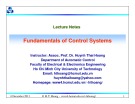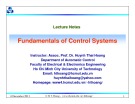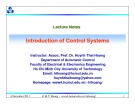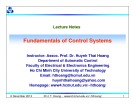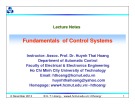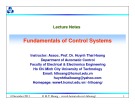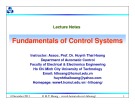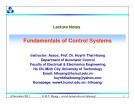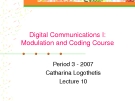
Fundamentals of control systems
-
Lecture "Fundamentals of control systems - Chapter 1: Introduction" presentation of content: What is control system, control principle, components off control systems, examples of control systems, review of complex variables and Laplace transform.
 93p
93p  doinhugiobay_17
doinhugiobay_17
 04-03-2016
04-03-2016
 74
74
 11
11
 Download
Download
-
Lecture "Fundamentals of control systems - Chapter 2: Mathematical models of continuous control systems" presentation of content: Presentation of content, transfer function, block diagram algebra, signal flow diagram, state space equation, linearized models of nonlinear systems.
 120p
120p  doinhugiobay_17
doinhugiobay_17
 04-03-2016
04-03-2016
 103
103
 8
8
 Download
Download
-
Lecture "Fundamentals of control systems - Chapter 3: System dynamics" presentation of content: The concept of system dynamics, dynamics of typical components, dynamics of control systems. Invite you to reference.
 54p
54p  doinhugiobay_17
doinhugiobay_17
 04-03-2016
04-03-2016
 84
84
 7
7
 Download
Download
-
Lecture "Fundamentals of control systems - Chapter 4: System stability analysis system stability analysis" presentation of content: Stability concept, algebraic stability criteria, root locus method, frequency response analysis.
 72p
72p  doinhugiobay_17
doinhugiobay_17
 04-03-2016
04-03-2016
 70
70
 7
7
 Download
Download
-
Lecture "Fundamentals of control systems - Chapter 8: Analysis of discrete control systems" presentation of content: Stability conditions for discrete systems, extension of Routh - Hurwitz criteria, jury criterion, root locus,... Invite you to reference.
 60p
60p  doinhugiobay_17
doinhugiobay_17
 04-03-2016
04-03-2016
 62
62
 7
7
 Download
Download
-
Lecture "Fundamentals of control systems - Chapter 9: Design of discrete control systems" presentation of content: Introduction, discrete lead - lag compensator and PID controller, design discrete systems in the Z domain,.... Invite you to reference.
 65p
65p  doinhugiobay_17
doinhugiobay_17
 04-03-2016
04-03-2016
 65
65
 7
7
 Download
Download
-
Lecture "Fundamentals of control systems - Chapter 6: Design pff continuous control systems" presentation of content: Introduction, effect of controllers on systems performance, control systems design using the root locus method,... Invite you to reference.
 103p
103p  doinhugiobay_17
doinhugiobay_17
 04-03-2016
04-03-2016
 85
85
 6
6
 Download
Download
-
Lecture "Fundamentals of control systems - Chapter 7: Mathematical model of discrete time control systems" presentation of content: Introduction to discrete - time system, the Z-transform, transfer function of discrete-time system,... Invite you to reference.
 48p
48p  doinhugiobay_17
doinhugiobay_17
 04-03-2016
04-03-2016
 63
63
 6
6
 Download
Download
-
Lecture "Fundamentals of control systems - Chapter 5: Analysis of control system performance" presentation of content: Performance criteria, steady state error, transient response, the optimal performance index,... Invite you to reference.
 0p
0p  doinhugiobay_17
doinhugiobay_17
 04-03-2016
04-03-2016
 64
64
 5
5
 Download
Download
-
Another class of linear codes, known as Convolutional codes. We study the structure of the encoder. We study different ways for representing the encoder.Convolutional codes offer an approach to error control coding substantially different from that of block codes. A convolutional encoder: encodes the entire data stream, into a single codeword. does not need to segment the data stream into blocks of fixed size (Convolutional codes are often forced to block structure by periodic truncation). is a machine with memory.
 20p
20p  doanhung_dtvtk10
doanhung_dtvtk10
 24-03-2013
24-03-2013
 53
53
 5
5
 Download
Download








